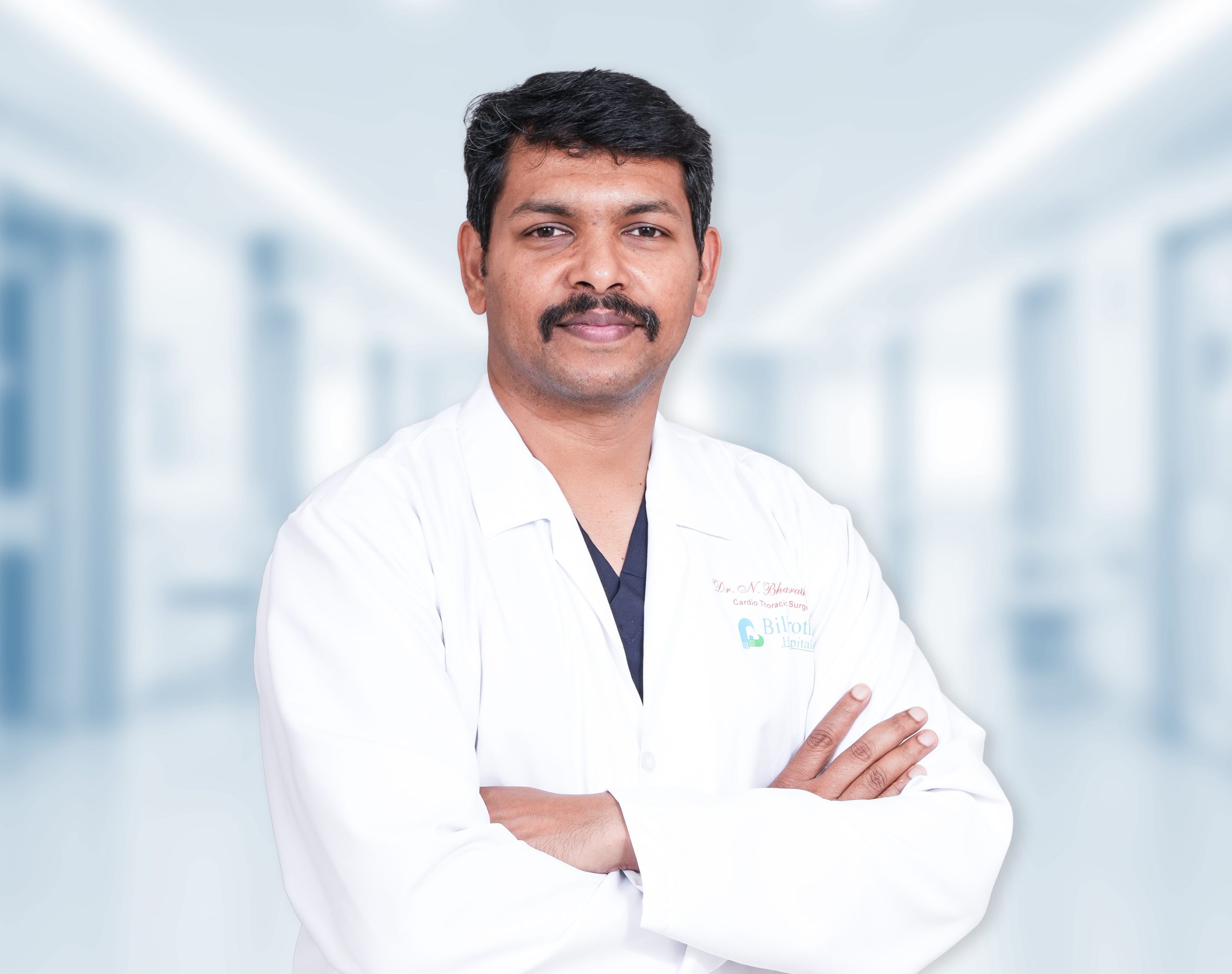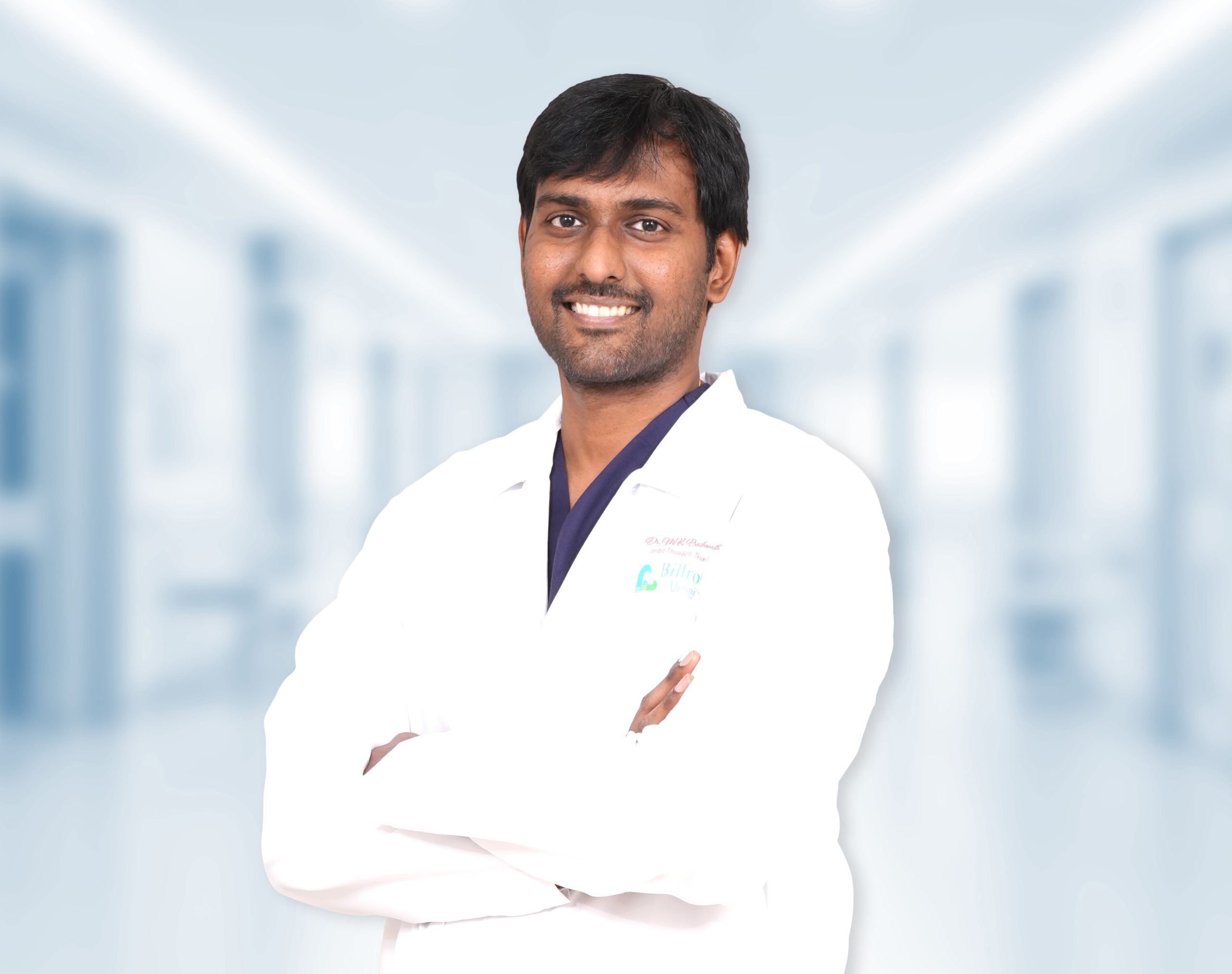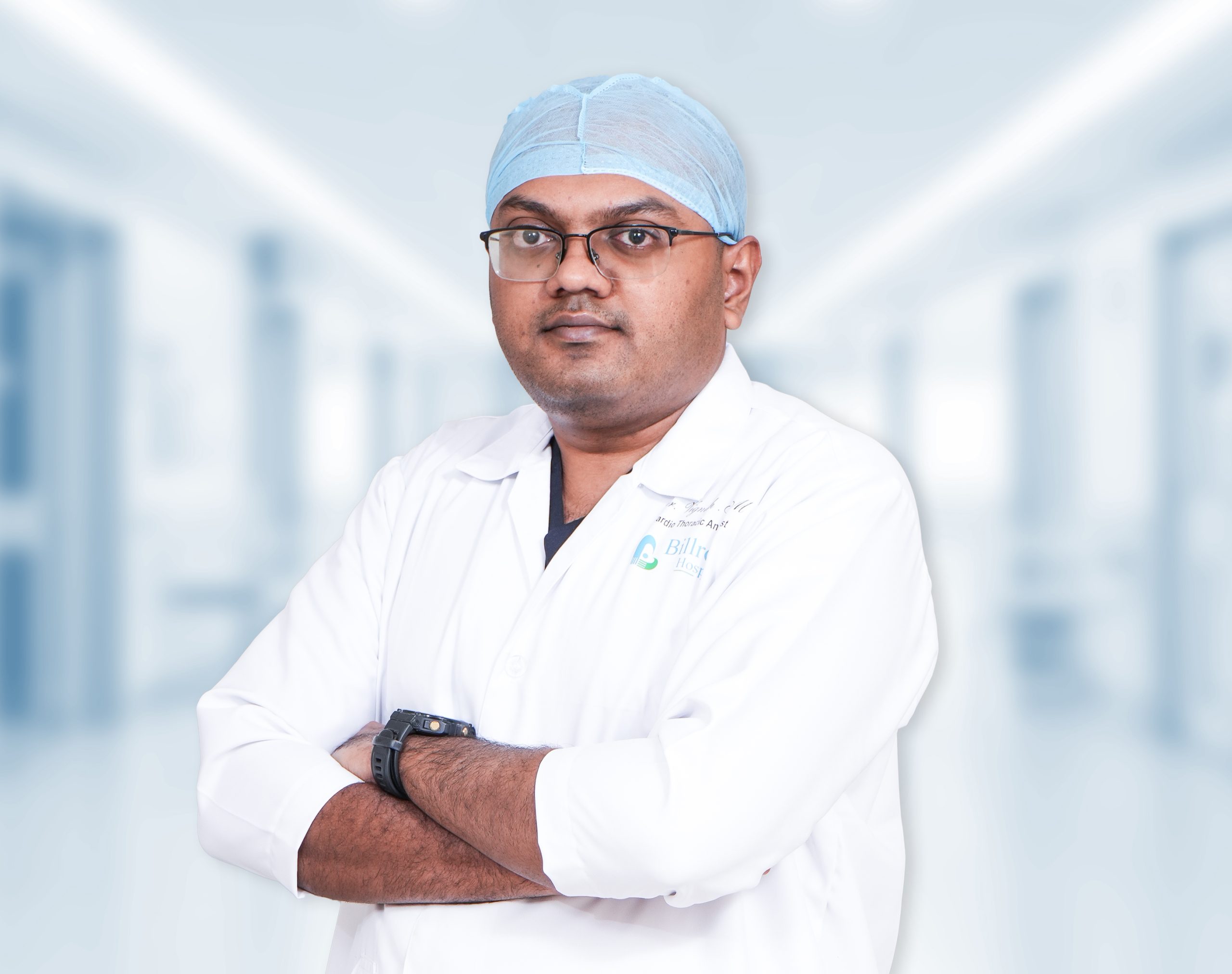- Overview
- Our Doctors
Department of Cardio-thoracic Surgery
Cardio-thoracic surgeryis a medical field that involves the surgical treatment of the thorax. It includes the heart, lungs, oesophagus, and other organs in the chest. This department plays a crucial role in managing a wide range of cardiovascular and thoracic disorders, including
- Coronary Artery Disease,
- Heart valve abnormalities,
- Congenital heart defects, and
- Thoracic malignancies.
Expert cardiothoracic surgeons lead the department, employing cutting-edge surgical techniques and technology to address complex cases. These procedures may involve coronary artery bypass grafting, heart valve repair or replacement, lung resections, and surgeries to treat aortic diseases. The department often collaborates closely with other medical specialties, such as cardiology, pulmonology, and oncology, to ensure comprehensive and multidisciplinary care for patients.
State-of-the-art facilities equipped with advanced imaging, monitoring, and surgical tools enhance the precision and success of cardiothoracic procedures. The medical staff, including surgeons, anesthesiologists, and nurses, undergo specialised training to handle the unique challenges posed by surgeries in this field.
Patient care extends beyond the operating room, encompassing pre-operative assessments, post-operative recovery, and long-term follow-up. The department focuses not only on treating diseases but also on preventive measures and lifestyle modifications to promote heart and lung health.
Coronary Artery Disease
When a person is diagnosed with heart disease, he is advised to undergo surgery, which may be open or closed heart surgery, depending on the complication. Closed Heart Surgery
A closed-heart surgery is an invasive method in which the heart is not opened directly and no heart-lung bypass machine is required. This reduces the chances of complications, and it is the first step in any further procedures hat deal with the heart. Closed heart surgeries are performed by opening the chest in front or through the ribs. This surgery deals with the arteries, which carry blood from and to the heart, rather than the chamber itself. Palliative heart surgeries are often performed on young children and are carried out in different stages.
Some examples of closed-heart surgeries are:
- Ligation of Patent Ductus Arteriosus,
- Repair of the coarctation of the aorta and
- The placement of pulmonary artery bands and Blalock-Taussig shunts
Every surgery is done by anaesthetizing the patients and providing post-surgical care such as regular monitoring of patients by keeping them in the ICU, providing intravenous medication to combat pain if any, and checking heartbeat and blood pressure at regular intervals.
Open Heart Surgery
Open heart surgery is highly invasive, as the name suggests. It involves opening the chest and heart to operate on its chambers, muscles, and arteries. One of the most common open-heart surgeries is coronary artery bypass grafting. It involves grafting a healthy artery or vein to carry blood, which becomes impossible with the blocked artery. Hence, the newly attached artery brings fresh blood, bypassing the old blocked one.
Today, open heart surgery has become a traditional method because of the advancements in this protocol. It involves just a small cut or incision, which is unlike the traditional method of wide opening. Open heart surgery is carried out with the help of a heart-lung machine.
Open heart surgeries are usually adopted for the following:
Coronary heart disease, which occurs due to the narrowing and hardening of blood vessels that provide blood and oxygen to the heart,.
In the replacement or repair of heart valves, through which blood flows from one chamber to another Replacement of a damaged heart with a donated heart
Beating Heart Surgery
Beating heart surgery is nothing but performing an open heart without the heart-liver machine while the heart is pumping, thus not stopping it during the surgery. Our surgeons use a tissue stabilisation system to mobilise the heart when required.
This surgery is carried out when the arteries cannot provide enough blood to the heart. In such cases, physicians mostly recommend coronary artery bypass graft (CABG) surgery.
The surgery is usually carried out using grafting techniques. The surgeon first gets a healthy vein or artery to act as a graft. One end of it is fixed inside the heart and the other end into the coronary artery just below the block, so that the blood flow bypasses the block thereby producing blood to the heart.
The surgeon uses a stabilisation method to keep the heart steady. The stabilisation system consists of a heart positioner and tissue stabilisation to hold the heart in place while it is being operated. The advantage of this type of surgery is that it reduces the risk that might occur when the heart is temporarily stopped, a condition called reperfusion that occurs when the surgeon fails to restore blood to the tissues.
Heart Valve Surgeries
The human heart consists of four valves: tricuspid, bicuspid, mitral, and aortic. These play a key role in the flow of blood from and into the heart. The well-known lub and tub sound of the heart is due to the closure of these heart valves. They are vital in maintaining one-way blood flow. Thus, any defect in any of these valves is a serious criterion to be addressed immediately. Every repair and replacement is done through open-heart surgery.
In the repair process, the physician adopts certain procedures. Some of them are listed below.
Commissurotomyis a technique to narrow the valves whose leaflets are thickened and get struck while closing. The surgeon cuts the joints where the leaflets meet to open the valve.
Valvuloplasty is a process in which the leaflets are strengthened to close tightly. It is an added support for the valve. A ring-like device is attached around the outside of the valve opening.
Reshaping is done to cut a portion of the leaflets, and when it is sewn again, the valve functions properly.
Decalcification is used to remove excess calcium storage in the leaflet, which, when removed, restores its function.
Repair is a structural support to replace or shorten the cords, which in turn supports the valves to close properly.
Patching is covering tears and holes in the leaflets with tissue patching.
If a valve is completely damaged and repair is not possible, replacement is the best way to fix it. Replacement is also done when there is a valve disease that may be life-threatening. It is often done to mitral and aortic valves.
Replacement can be either mechanical or biological.
In the mechanical method, the valve is made of plastic, carbon, or metal, which is strong and long-lasting. When blood passes through these valves, it has a chance to thicken and clot in some areas, which again becomes a problem. Hence, patients are advised to take blood-thinning medicine throughout their lives.
In the biological method, the valve is made up of either animal tissue or human tissue from the heart that is donated. In some cases, the patient’s tissue is also used. This is not as strong as mechanical valves, and it needs replacements once every 10 years or so, but in this case, blood thinner medicine is not required.
Congenital heart disease
Congenital heart disease is nothing but some defect in the heart right from birth. The defect can be in the walls, the valves, or in the flow of blood to the heart. Doctors usually identify such defects either during pregnancy or immediately after birth. Some of the
symptoms include:
- Rapid breathing
- Fatigue
- Poor blood circulation
- Cyanosis (bluish skin, lips, and fingernails)
There are many types of congenital heart disease. Some of the common defects include
Pulmonary stenosis is a defect in which the pulmonary valve through which the blood from the right ventricle of the heart reaches the lungs gets hard and narrowed. In such a case, the ventricle presses itself to pump more blood, which results in swelling of the right ventricle.
Pulmonary atresia is a defect in which the pulmonary valve, which allows the flow of blood from the right ventricle to the lungs, remains closed at birth. As a result, the blood never reaches the lungs from the right ventricle, where it gets oxygenated. This may turn out to be severe if the condition remains untreated.
Tricuspid atresia is a defect in the tricuspid valve in which the flow of blood from the right atrium to the right ventricle is blocked. The valve would not have been developed fully or opened to allow blood flow. Hence, the blood to the lungs is blocked, which is again a major defect that leads to death when untreated.
Aortic stenosis is a defect in the aortic valve, which allows the flow of blood from the left ventricle to the aorta, the largest artery that carries oxygen-rich blood from the heart to different parts of the body. When this valve is thickened, the blood supply to various parts of the body becomes insufficient, thereby supplying less oxygenated blood to the body.
Coarctation of the aortais a defect in which the aorta is constricted, which carries blood to the lower parts of the body.
There are other defects apart from this. A hole in the heart is one of the major congenital heart problems. During birth, the opening in the wall of the heart allows blood to flow from the right and left chambers themselves instead of pumping to other parts of the body. It causes the heart to swell and enlarge. Some of the problems with a hole in the heart are
An atrial septal defect is a hole between the atria. The blood from the left atrium should flow to the left ventricle and then to the aorta and the whole body. But in this case, due to the hole, blood flows from the left atrium into the right atrium, which becomes fatal in later stages.
A ventricular septal defect is a hole in the ventricle. Blood from the lungs is returned to the heart through the left ventricle to enter the aorta and then to the rest of the body. In this case, blood flows from the left ventricle to the right ventricle. The complications are more common in such cases.
Congenital heart diseases are diagnosed through different methods.
- Cardiac catheterization is done to check blood pressure inside the heart and get images of the chambers of the heart.
- Chest x-ray to show the size and shape of the heart and lungs and other bone conditions.
- Echocardiogram to show the size and pumping action of the heart along its valves.
- Electrocardiogram to record the electrical activity of the heart
Minimally Invasive Bypass Surgery
It is nothing but a bypass surgery that is performed with several small incisions instead of the traditional method of wide-opening the chest. This type of surgery may help patients who were neglected by older methods of heart surgery due to age. It has a wide range of advantages, like less blood loss, fewer post-surgery discomforts, fast healing, a lower infection rate, less trauma, fewer scars, etc. Minimally invasive bypass surgery gives the physician a clearer image of other parts of the heart than traditional methods.
Some of the minimally invasive surgeries include
- Aortic valve surgery
- Atrial septal defect closure
- Heart valve closure surgery
- Maze heart surgery
- Mitral valve surgery
- Tricuspid valve surgery
- Thoracic Malignancy Surgeries
Thoracic malignancy surgeries involve procedures on the organs within the chest, commonly the lungs and esophagus. Common surgeries include lobectomy for lung cancer, esophagectomy for esophageal cancer, and mediastinal tumour resection. Each surgery aims to remove or address cancerous tissue while preserving healthy structures to the extent possible. The specific approach depends on factors like the type and stage of malignancy.
- Lobectomy: This involves the removal of a lobe of the lung and is a common procedure for lung cancer.
- Pneumonectomy: The entire lung is removed, often necessary for extensive lung tumours.
- Segmentectomy: This surgery removes a segment of the lung, preserving more healthy tissue compared to a lobectomy.
- Wedge Resection: Removal of a small, wedge-shaped portion of the lung containing the tumour.
- Esophagectomy: This surgery is performed for esophageal cancer, involving the removal of part or all of the oesophagus.
- Mediastinal Tumour Resection: Surgery to remove tumours in the mediastinum, the space between the lungs.
- Thymectomy: removal of the thymus gland, often done for thymic tumours or myasthenia gravis.
- Chest Wall Resection: In cases where the tumour involves the chest wall, a portion may need to be removed.
- Video-Assisted Thoracoscopic Surgery (VATS): minimally invasive procedures using small incisions and a camera for visualisation
The other two major areas are heart and lung transplantation.
Cardiothroracic Surgery Doctors
Meet the Team – Best Cardiothoracic Surgeon in Chennai






